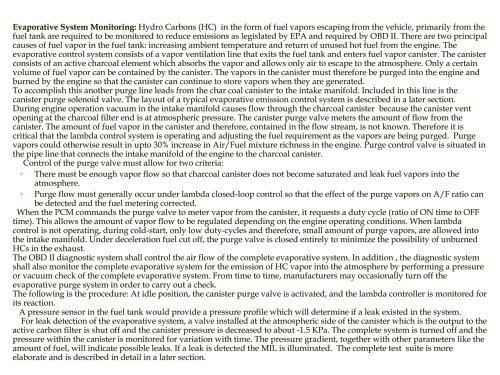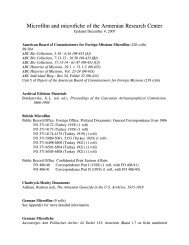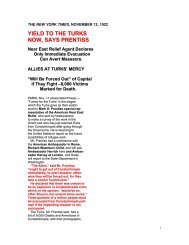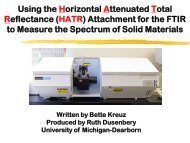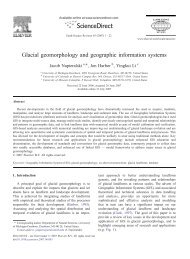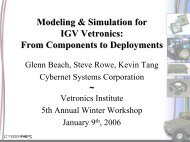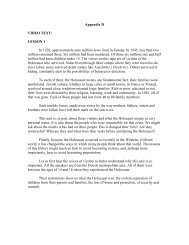Introduction to On Board Diagnostics (II)
Introduction to On Board Diagnostics (II)
Introduction to On Board Diagnostics (II)
Create successful ePaper yourself
Turn your PDF publications into a flip-book with our unique Google optimized e-Paper software.
Evaporative System Moni<strong>to</strong>ring: Hydro Carbons (HC) in the form of fuel vapors escaping from the e vehicle, primarily from thefuel tank are required <strong>to</strong> be moni<strong>to</strong>red <strong>to</strong> reduce emissions as legislated by EPA and required by OBD <strong>II</strong>. There are two principalcauses of fuel vapor in the fuel tank: increasing ambient temperature and return of unused hot fuel from the engine. Theevaporative control system consists of a vapor ventilation line that exits the fuel tank and enters fuel vapor canister. The canisterconsists of an active charcoal element which absorbs the vapor and aallows only air <strong>to</strong> escape <strong>to</strong> the atmosphere. <strong>On</strong>ly a certainvolume of fuel vapor can be contained by the canister. The vapors s in the canister must therefore be purged in<strong>to</strong> the engine andburned by the engine so that the canister can continue <strong>to</strong> s<strong>to</strong>re vapors when they are generated.To accomplish this another purge line leads from the char coal canister c<strong>to</strong> the intake manifold. Included in this line is thecanister purge solenoid valve. The layout of a typical evaporative ve emission control system is described in a later section.During engine operation vacuum in the intake manifold causes flow w through the charcoal canister because the canister ven<strong>to</strong>pening at the charcoal filter end is at atmospheric pressure. The Tcanister purge valve meters the amount of flow from thecanister. The amount of fuel vapor in the canister and therefore, , contained in the flow stream, is not known. Therefore it iscritical that the lambda control system is operating and adjusting the fuel requirement as the vapors are being purged. Purgevapors could otherwise result in up<strong>to</strong> 30% increase in Air/Fuel mixture richness in the engine. Purge control valve is situated inthe pipe line that connects the intake manifold of the engine <strong>to</strong> the charcoal canister.Control of the purge valve must allow for two criteria:• There must be enough vapor flow so that charcoal canister does not nbecome saturated and leak fuel vapors in<strong>to</strong> theatmosphere.• Purge flow must generally occur under lambda closed-loop loop control so that the effect of the purge vapors on A/F ratio canbe detected and the fuel metering corrected.When the PCM commands the purge valve <strong>to</strong> meter vapor from the canister, it requests a duty cycle (ratio of ON time <strong>to</strong> OFFtime). This allows the amount of vapor flow <strong>to</strong> be regulated depending on the engine operating conditions. When lambdacontrol is not operating, during cold-start, only low duty-cycles and therefore, small amount of purge vapors, are allowed in<strong>to</strong>the intake manifold. Under deceleration fuel cut off, the purge valve is closed entirely <strong>to</strong> minimize the possibility of unburnedHCs in the exhaust.The OBD <strong>II</strong> diagnostic system shall control the air flow of the complete cevaporative system. In addition , the diagnostic systemshall also moni<strong>to</strong>r the complete evaporative system for the emission ion of HC vapor in<strong>to</strong> the atmosphere by performing a pressureor vacuum check of the complete evaporative system. From time <strong>to</strong> time, manufacturers may occasionally turn off theevaporative purge system in order <strong>to</strong> carry out a check.The following is the procedure: At idle position, the canister purge pvalve is activated, and the lambda controller is moni<strong>to</strong>red forits reaction.A pressure sensor in the fuel tank would provide a pressure profile pwhich will determine if a leak existed in the system.For leak detection of the evaporative system, a valve installed led at the atmospheric side of the canister which is the output <strong>to</strong> theactive carbon filter is shut off and the canister pressure is decreased <strong>to</strong> about -1.5KPa. . The complete system is turned off and thepressure within the canister is moni<strong>to</strong>red for variation with time. The pressure gradient, <strong>to</strong>gether with other parameters like theamount of fuel, will indicate possible leaks. If a leak is detected ted the MIL is illuminated. The complete test suite is moreelaborate and is described in detail in a later section.


